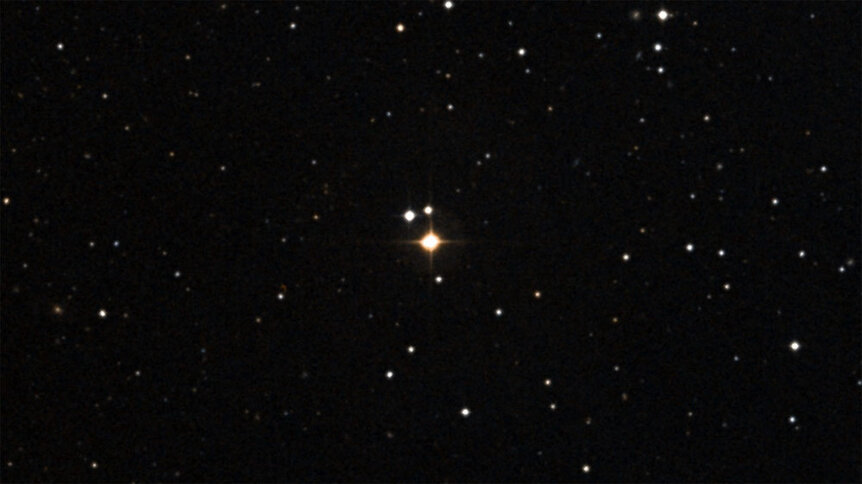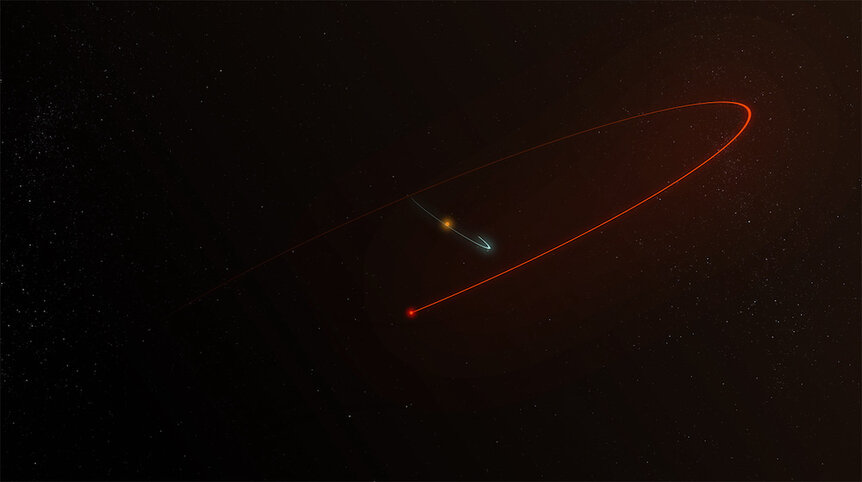Create a free profile to get unlimited access to exclusive videos, sweepstakes, and more!
A telescope the size of the Earth sees the wobble of a bizarre planet in a binary star
GJ 896Ab is a planet of many odd characteristics.

It’s a rare thing when every single part of an astronomy news story is super cool, but here we are. You’ll want to stick around for all of this.
A telescope the size of the planet has observed a binary red dwarf star system for 14 years, nailing down the positions of the two stars to incredible accuracy, and happened to discover a planet more massive than Jupiter orbiting one of them in a plane hugely tilted to the orbits of the stars around each other.
Oh, yes. This is my kind of story [link to paper].
The star system is called GJ 896, and it’s a pair of low-mass red dwarfs 20.37 light-years from Earth — and yes, as I’ll get to, the distance is known that accurately. The more massive of the two, GJ 896A, is about 0.44 times the mass of the Sun, and its companion star, GJ 896B, is much smaller at 0.165 solar masses. So both are dinky. Even though they’re among the closest stars known to the Sun, they’re so faint you need a telescope to see them at all.
Between 2006 and 2011, and again in 2020, these stars were observed using the Very Long Baseline Array, a collection of radio dishes spread across Earth. They observe at the same time, and their data are then combined in a way that makes their vision as keen as if they were a single dish the size of the planet. This technique, called interferometry, has been used for decades, and perhaps is currently most famous as used by the Event Horizon Telescope to look at the black holes in the center of the Milky Way and M87.
The resolution of a telescope — its ability to very accurately measure the position of an object, or separate two objects in the sky — depends in part on its size, so a telescope over 10,000 km wide has phenomenal resolution. The observations of GJ 896 are accurate to about 60 microarcseconds, a very tiny angle in the sky. There are 3,600 arcseconds in a degree, for example, and the Moon is 0.5 degrees = 1,800 arcseconds across. A microarcsecond is a millionth of an arcsecond, so this resolution is like being able to see a cell phone sitting on the Moon’s surface.
Even older, lower resolution observations were accurate enough to see the orbital motion of the two stars around each other. The orbital period is about 229 years, and they’re separated by about 4.5 billion kilometers from each other, the same distance Neptune is from the Sun.
The new measurements are easily enough to pick up the parallax induced by the Earth’s motion around the Sun. As we go around the Sun we see the stars from one angle and then a different angle six months later. This parallax is the same idea as holding your thumb in front of your face and closing first one eye then the other; your thumb will appear to move against the background. This technique is used to get the distances to stars, and in fact is why the distance to GJ 896 is so well determined.
Once that effect is subtracted, and the orbital motion of the two stars around each other is subtracted, something very strange can be seen: The primary star, GJ 896A, is corkscrewing through space, making one cycle around every 284.4 days. The cause must be something small orbiting it, its gravity tugging on the star and causing it to spiral through the galaxy. Given the period of the tug, the astronomers have determined it’s a planet with about 2.3 times the mass of Jupiter.
The planet itself is invisible, but the effects of its gravity can be seen in the positions of GJ 896A over time. The process of measuring a star’s position is called astrometry, and it’s very rare indeed to find a planet using this method. This one, called GJ 896Ab, is one of the very few to have been found this way.
And it gets better: Very careful measurements of the planet’s orbit show it orbits the star in a plane wildly tilted to the orbital plane of the two stars, tipped by 148°. That’s weird. Like, really weird.
All the major planets in the solar system orbit in more or less the same plane. A handful of exoplanets have been found to orbit at large angles to other planets on their systems, and it’s not clear why. Perhaps one planet migrated too close to another and the gravitational interaction slingshot it into the tilted orbit. Maybe over time the gravitational influence of the second star pumped the inclination of the planet’s orbit until its tilt changed to where it is now. Or maybe it had something to do with the way the planet and stars formed in the first place. We don’t know yet.
And mind you, the planet itself is weird. We know of lots of planets orbiting red dwarf stars, but far and away the majority of them are small, Earth-sized planets. Very few are gas giants, let alone with more than twice the mass of Jupiter. This system is bizarre in almost every way we look at it, which of course makes it more fun to study.
This is the first time the full three-dimensional motions of a binary star and an exoplanet orbiting one of them have been determined. That in itself is pretty cool, but when you add everything else in, this becomes one of the most interesting star/planet systems we know. And the cherry on top is that it’s so close to us we can actually study it in some detail.
Its proximity makes me wonder, too. If such systems were super-rare in the galaxy, you’d expect the nearest one to be thousands of light-years away. The fact that GJ 896 is one of the closest star systems to the Sun in the entire galaxy implies these sorts of things are common. The only way we can find out is to study as many binary red dwarfs as we can, and keep watching GJ 896 closely. Hopefully longer-term observations will solve the mystery of the planet’s tilted orbit, why it’s so big, and just how this wild and wonderful system came to be.





























